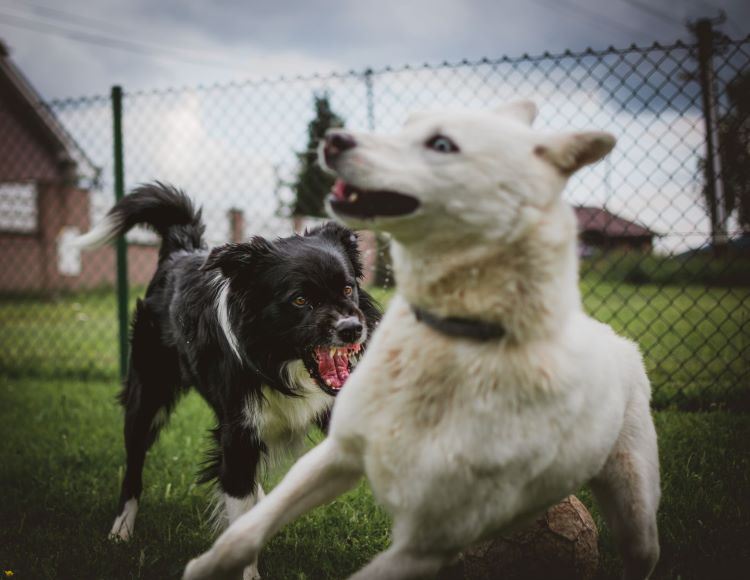
Dogs can be remarkably emotional, intelligent, and loving creatures. Unlike people, dogs cannot speak their minds, and oftentimes may be in distress with no way to completely express it. Most of the time this is ok because through trial and error a person can figure out what is wrong, and fix the problem like if the dog must go to the bathroom, is hungry, or is anxious.
One way to understand dogs better is to read their body language. There are plenty of positive traits that dogs show through body language, but there are also very specific negative ones that, if understood properly, can prevent the dog from causing harm. Sometimes accidents simply cannot be avoided, but if you are faced with a foreign dog, the ability to read its body language can decrease the likelihood of the dog lashing out towards you.
1.) COWERING
You may be walking down the street one day and come across a dog and its owner walking in the opposite direction. If you are inclined to pet the dog, you should try to see if, when you move forward, the dog begins to cower or back away. This is a sign that the dog is nervous or scared that you are going to cause harm, and is reacting by moving itself away from you. At this point, the best action to take is to allow the dog its space and continue on your way. The dog will be happy that it avoided a potential threat, and you can continue un-injured!
2.) BARING TEETH
If a dog bares its teeth at you, that means that he is prepared to attack if you continue to invade its space. Hopefully, if you encounter a dog like this, it will be on a leash or in a safe area in which it cannot get out. Other signs to watch for are a quickly wagging tail, raised ears, direct eye contact, and rigid posture.
No matter the situation, the best action to take is to leave the dog alone by avoiding eye contact and moving slowly away. Baring teeth is generally a warning stating that if you come any closer, or continue what you are doing, I will attack.
3.) LACK OF MOVEMENT
If you happen across a dog that you are unfamiliar with, and it is staying completely still regardless of you or anything around it, you may think it is ok to pet or interact with it. Unfortunately, when a dog is completely motionless, this is a sign that they are extremely distressed.
When a dog doesn’t like something, it may try different behaviors to get it to stop. When a dog lacks movement of any kind, it is usually a sign of their last effort to get a negative stimulus to stop. Unless you know the dog well, or can ask its owner what is going on, always avoid dogs that are staying still and not reacting to sounds, or your movement.
4.) RAISED HAIR
Similar to our “goosebumps” – dogs will instinctively raise their hair on their back when they sense a threat. Whenever handling a dog, always watch for any changes to their appearance and behavior in case they begin to feel threatened or scared. You could be petting a dog, and all of a sudden its hair raises. As with most other signs, you should back away slowly, and avoid eye contact.
5.) EYE CONTACT
Although this behavior has been mentioned several times, it is probably the most telling behavior a dog can demonstrate. When a dog makes or avoids eye contact with someone or something, it is nearly always a sign of something deeper. Eye contact between one person to another can be similar – it may mean that you are looking at someone to be friendly and acknowledge them, or depending on the intensity, could mean that one person is about to become violent with another. The signs are quite similar in that the intensity changes.
If a dog is acting playful and looks you in the eyes, it does not mean it is about to attack. On the contrary, if a dog makes eye contact with you while exhibiting a tense or abnormal additional behavior, such as growling or cowering, it is a sign that you should back off.
Dogs very rarely become aggressive, and when they do, they almost always show signs that they are scared, tense, anxious, or angry. When you see a dog behave in a way that makes you feel they are not excited to see you do not extend yourself thinking you can calm the dog by petting it or getting closer. Just back off and give the dog some space. According to the Centers of Disease Control and Prevention (CDC), 1 in 5 people that are bitten by a dog requires medical treatment. Unfortunately even when taking every precaution, a dog may attack, but making an effort to prevent it may save you from serious injury.
If a dog feels comfortable, it will make it obvious that it wants to be friendly!
CLICK HERE to contact us if you or someone you know has been bitten by a dog, as the victim may be entitled to compensation. If you would like to speak to us, our phone number is (404) 969-1284.




